Pickleball is fast-paced and surprisingly addictive game, which beautifully blends elements from tennis, badminton, and ping-pong, and is quickly garnering a global fanbase.
Whether you’re a seasoned athlete looking for a new challenge, or a beginner wondering how to hold a paddle, you’ve come to the right place. Let’s delve into Pickleball – the game, the rules, the technique and what is the best way to learn pickleball? So, tighten your grip and prepare yourself for lots of fun and action – Pickleball 101 is about to begin!
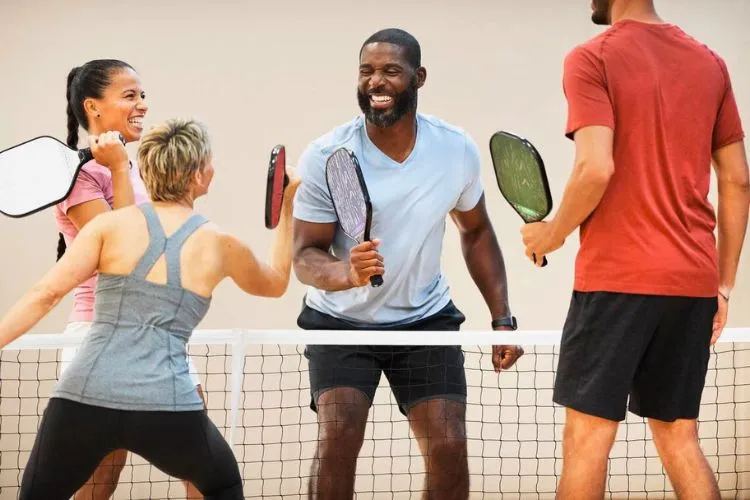
What is the best way to learn pickleball?
Pickleball, while straightforward, requires a mix of strategy, skill, and practice. If you’re interested in learning the game, here’s a detailed step-by-step guide to help you get started:
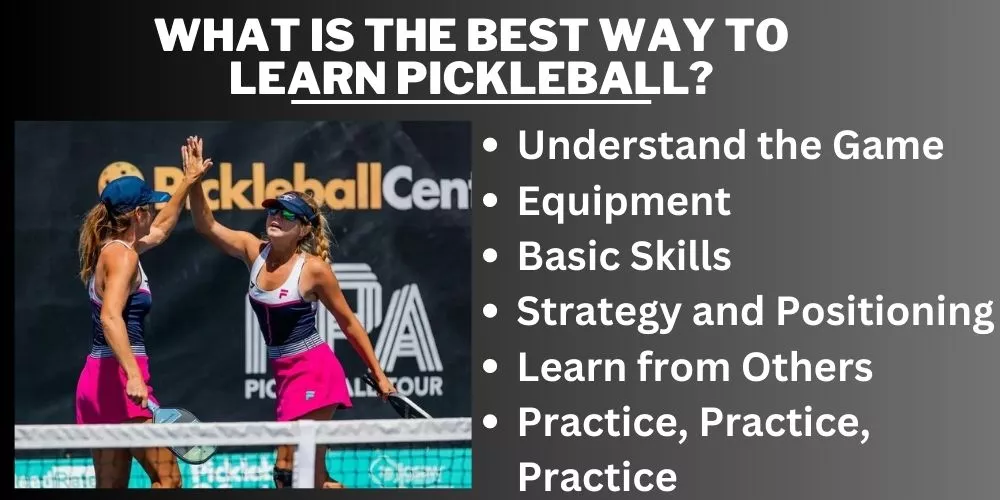
Understand the Game
- Basics: Familiarize yourself with the basic rules, terms, and equipment. Read articles, books, or online resources dedicated to Pickleball.
- Watch games: Attend local pickleball games or watch online videos to better grasp the game’s flow, strategies, and techniques.
Equipment
- Paddle: Pick a paddle based on your comfort. Lightweight paddles offer quicker hands, while heavier ones provide power.
- Ball: Balls designed specifically for pickleball are necessary, as their unique design plays a big role in how the game is played.
- Court: Familiarize yourself with a pickleball court. Its dimensions and understanding the use of different zones such as ‘kitchen’ are crucial.
Basic Skills
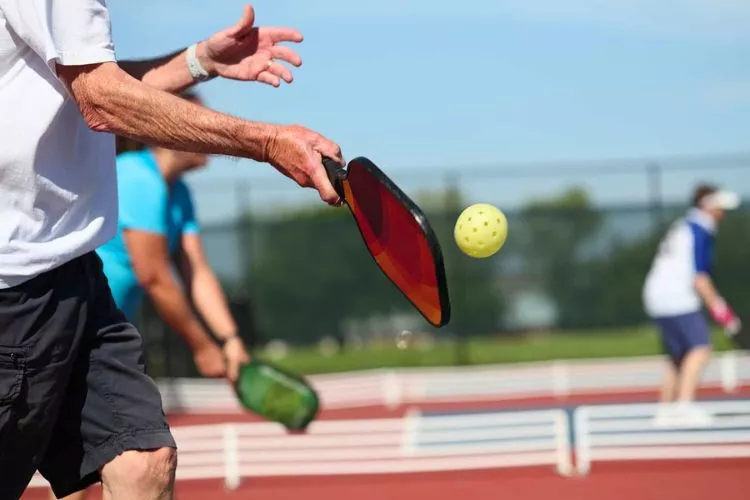
Serve
- Stance: Stand behind the baseline with feet shoulder-width apart, facing the net diagonally.
- Grip: Hold the paddle using the “Eastern” grip. It resembles shaking hands with the paddle, laying it flat on your fingers while placing your thumb behind it.
- Ball Toss: Hold the ball comfortably off-hand and let it drop, maintaining paddle contact below your waist level.
- Swing: With a smooth motion, swing your arm forward and slightly upward, ensuring the paddle always stays below your navel.
- Contact: Strike the ball with the paddle’s sweet spot (middle part) to ensure an accurate and powerful serve.
- Follow-Through: Continue the swinging motion even after contacting the ball, which helps to maintain accuracy and control.
Forehand & Backhand
To practice forehand and backhand shots, follow these guidelines:
Forehand:
- Stand with your feet shoulder-width apart, knees slightly bent, and perpendicular to the net.
- Hold the paddle before you with the striking surface facing the net.
- Rotate your hips and shoulders towards the net while swinging your paddle forward, contacting the ball in front of your body.
- Complete the motion, allowing your paddle to naturally continue its path after contacting the ball.
Backhand: Same as the forehand stance, but instead, face the direction opposite to your playing hand. Hold the paddle across your body, with the striking surface facing the net. Rotate your hips and shoulders away from the net, swinging your paddle forward, and contacting the ball in front of your body. Finish the motion, allowing the paddle to continue after contacting the ball.
Volley
Stand with your feet shoulder-width apart, knees slightly bent, and weight on your toes. Hold the paddle with both hands, pointing towards the net. Focus on quick reflexes and anticipating the direction of the incoming ball.
Use a short, controlled punching motion to hit the ball without a full swing. Aim to contact the ball close to your body and directly before you.
Dink
Assume a low, athletic stance with bent knees and a low center of gravity. Use a gentle grip on the paddle, and soften your forearm and wrist. Slightly open the paddle face to help lob the ball at a higher arc.
Minimize your backswing and follow-through, focusing on simply guiding the ball over the net. Aim to contact the ball below your knees, allowing a soft drop into the opponent’s kitchen.
Strategy and Positioning
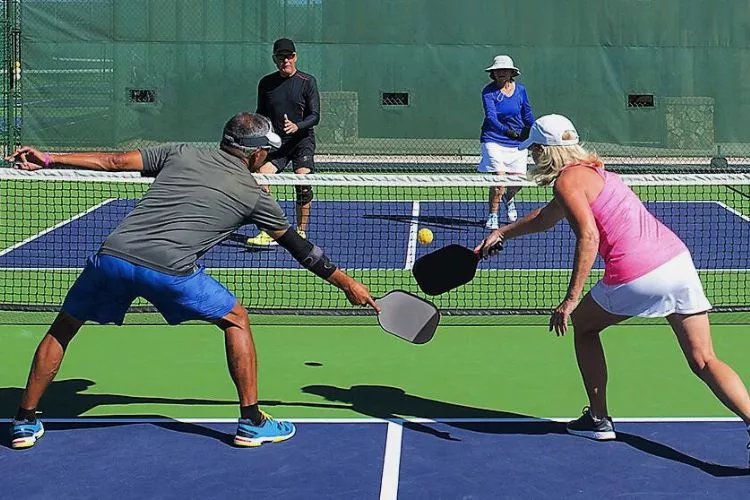
Doubles Court Positioning
Adopting the correct court positions in doubles play can significantly improve your performance:
- Side-by-Side Stance: Always aim to be parallel with your partner. This stance increases the coverage of the court and minimizes gaps that opponents can exploit.
- Net Control: Try to gain control of the net as much as possible. Being closer to the net allows you to put more pressure on your opponents. However, be mindful of your foot positioning to avoid entering the kitchen.
- Stacking: This advanced technique involves positioning the stronger player on one side of the court (usually the side where the ball is being served) to maximize their involvement.
- Movement Synchronization: Move in sync with your partner to maintain a solid defense. If one player moves to the net, the other should follow, ensuring no area is left unguarded.
Singles Court Positioning
For singles, positioning is different:
- Center Base: The middle of the court, i.e., the baseline’s center, is the optimal space to return to after every shot. It allows you to reach the ball quickly, no matter which side it lands on.
- Net Play: Move towards the net when the opponent hits a weak or high return. It lets you control the play with drop shots or volleys.
- Defensive Position: If your opponent is at the net and controlling the game, move several feet behind the baseline. It gives you more time to react and return accurately.
Shot Strategy
Knowing when and how to use different shots can give you an edge:
- Drive: Use a hard drive to put your opponents on the defensive or when positioned too close to the net. It’s powerful, fast, and gives your opponent less time to react.
- Drop: Use a drop shot if your opponents are well away from the net. It falls softly in the kitchen, forcing them to move forward quickly, which might induce errors.
- Volley: Volleys are ideal when you’re closer to the net. They impart less reaction time on your opponents and keeps you in control of the game.
- Dink: Dinks are strategic in keeping your opponents back and forth on their feet. This soft shot, executed properly, can force errors from opponents, especially those who lack patience.
- Lob: An occasional well-placed lob can make your opponents scramble. Use it sparingly, ideally when your opponent is too close to the net.
You can control the court and keep your opponents guessing by strengthening your positioning and shot-selection strategies.
Learn from Others
- Coaching Sessions: If feasible, register for coaching sessions. They can provide personalized feedback and advanced strategies.
- Local Club: Join a local pickleball club. It offers an opportunity to practice, learn from others, and make friends.
- Online Communities: Join online forums or social media groups dedicated to pickleball. They can offer tips, answer queries, and help improve your game.
Physical fitness plays a key role. Regular cardio exercises, strength training, and agility drills can enhance your performance on the court.
Practice, Practice, Practice
There’s no substitute for practice. Play as often as you can. Be patient, persistent, and always aim for progress, not perfection.
Remember: Pickleball should be fun! Enjoy each game and celebrate your progress. Happy Pickleballing!
Other Articles That May Help You, If you want to Learn Pickleball: Shots Pickleball Beginner Should Know | Pickleball Tips For Players Of All Levels | What is a key strategy in pickleball?
What is Pickleball?
Pickleball is a paddleball sport that combines elements from tennis, badminton, and table tennis. This unique mix creates a game that is fun and highly social and offers an excellent workout.
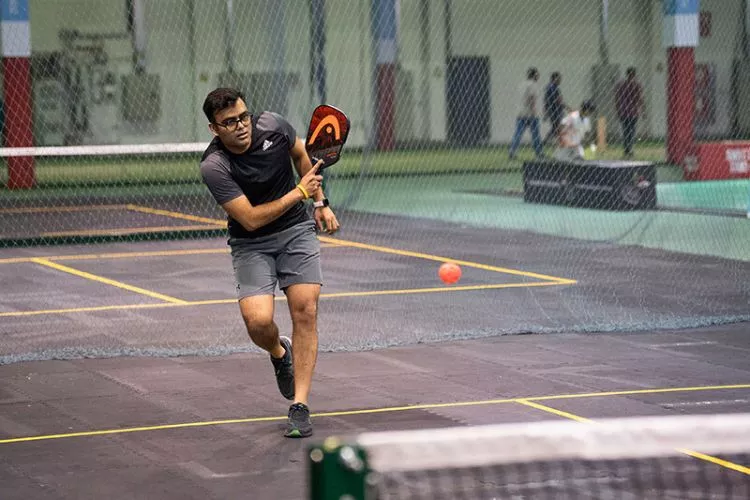
Here are the basics:
- Game Equipment: Pickleball is primarily played on a badminton-size court using solid paddles (generally made from wood or lightweight composite materials) and a perforated plastic ball similar to a wiffle ball.
- The Play: Players can compete as singles or doubles, like in tennis or badminton. The objective is to serve the ball diagonally, aiming for the opponent’s court. The goal is for the opponent to fail in returning it.
- Scoring: A team scores points only when they serve. Games are typically played to 11, 15 or 21 points, with the winning team leading by at least 2 points.
- The Unique ‘Kitchen’ Rule: The area 7 feet from the net on each side is the non-volley zone, also known as “the kitchen”. Players must not volley (hit the ball before it bounces) when they’re in the kitchen.
Pickleball’s ease of learning and its potential for competitive play make it an attractive sport for individuals of all ages and skill levels. So why not grab a paddle and a ball and try it? You might just find your new favorite sport!
how do you play pickleball? (Rules)
Pickleball has straightforward rules that even beginners can quickly understand. Let’s delve deeper into them:
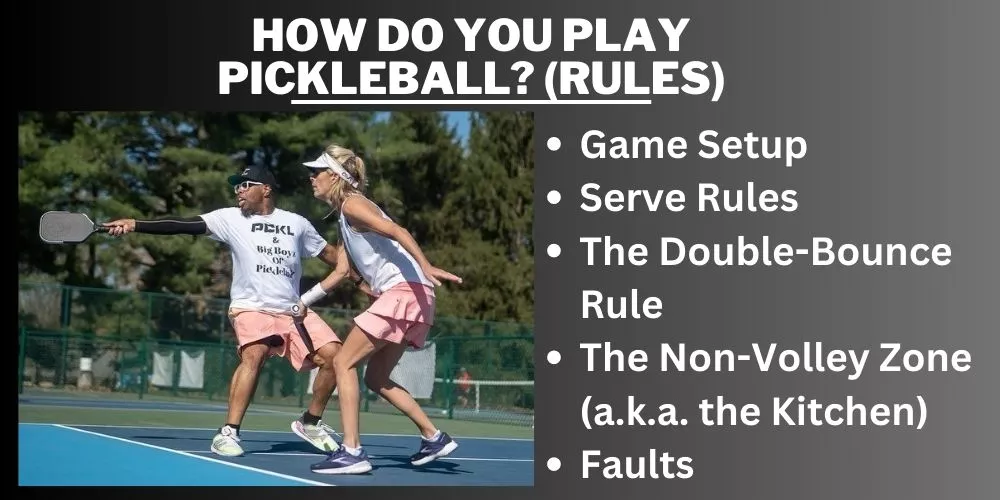
Game Setup
- Court size: Similar to badminton, the court measures 20 feet wide by 44 feet long and is divided into two equal sides by a net that stands 36 inches on the edges and 34 inches in the middle.
- Scoring: A pickleball game is typically played to 11 points but may be extended to 15 or 21. The team must win by 2 points.
- Singles or Doubles: Pickleball can be played in singles mode (one player per team) or doubles (two players per team).
Serve Rules
- Serve Direction: The server must serve diagonally, directing the ball to the opponent’s court.
- Serve Sequence: At the start of the game, the player on the right side (even court) serves first. In doubles, teammates alternate their serves.
- Serve Motion: The serve should be made underhand with the paddle below the waist and must be hit before it bounces.
The Double-Bounce Rule
Each team must make at least one groundstroke after the serve and the return of serve. The ball must bounce once on each side before volleys are allowed.
The Non-Volley Zone (a.k.a. the Kitchen)
- A ‘kitchen‘ is the 7-foot zone on both sides of the net. Volleys are prohibited within this space, i.e., you cannot hit the ball before it bounces if you are standing in the ‘kitchen’.
- Striking the ball in the air while in the non-volley zone results in a fault. However, a player can enter the kitchen to play a ball bounced there.
Faults
A few actions are considered faults in pickleball. These include:
- Hitting the ball out of bounds.
- Stepping into the non-volley zone (the ‘kitchen’) to volley a ball.
- A serve that does not land into the diagonal court box.
- Hitting the ball before it has bounced once on each side of the net after a serve.
Each fault leads to a change of serve, or side out if the serving team made the fault. Understanding these rules is the first step into Pickleball’s fun, action-packed world. So grab your paddle and ball, and start practicing!
Frequently Asked Questions (FAQs)
How do you dink better in pickleball?
To dink better in pickleball, adopt a low and athletic stance, use a gentle grip on the paddle, soften your forearm and wrist, slightly open the paddle face to achieve a higher arc, minimize your backswing and follow-through, and aim to contact the ball below your knees. Practicing dinking consistently will help improve your touch and control, making it a highly effective tool during games.
Can I practice pickleball by myself?
Yes, you can practice pickleball by yourself using a wall or a rebounder designed for pickleball. Practicing serves, forehand and backhand shots, volleys, and dinks can be done solo. While practicing alone can help improve your technique and hand-eye coordination, playing with others is essential to enhance your game awareness, strategy, and teamwork skills.
Is it hard to be good at pickleball?
Becoming good at pickleball requires consistent practice, patience, and dedication to the sport. While learning the basics is relatively easy, focusing on improving your skills, understanding strategies, and maintaining physical fitness is essential. Participating in coaching sessions, joining a local club, and engaging in regular practice will help you gradually become proficient at the game.
Can you play pickleball if you’re out of shape?
Yes, you can start playing pickleball even if you’re out of shape. Pickleball is a versatile sport friendly to players of all ages and fitness levels. It’s ideal for individuals looking to enter a sport while improving their physical fitness. However, it’s crucial to keep safety in mind, gradually increase your playing intensity, and do supplemental exercises like cardio, strength training, and stretching to prevent injury and enhance your overall fitness.
Conclusion:
Pickleball combines elements from tennis, badminton, and ping-pong, resulting in a fun, accessible, and highly addictive sport that people of all ages and skill levels can enjoy. The basic rules are easy to grasp and the equipment requirement is minimal, making it an ideal sport for beginners. As for what is the best way to learn pickleball? I should say as you delve into the game, you’ll find many opportunities to develop new techniques, strategies, and a better understanding of the game.
Whether you want to compete, get in shape, or have more social interactions, pickleball can be the perfect sport. No matter your motivation, remember the essence of the game is to enjoy, stay active and have fun.

Pickleball’s more than a game to me—it’s a passion. I write, sharing its highs and lows, the thrills and the lessons. Some tales might draw you to the court, while others give a hint of the game’s magic. So, curious about my journey? Ready to dive deep into the world of pickleball with me? Let’s go.
